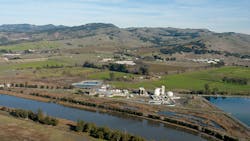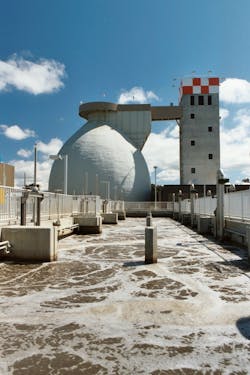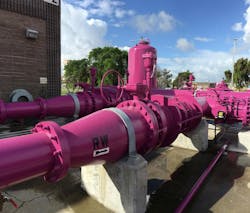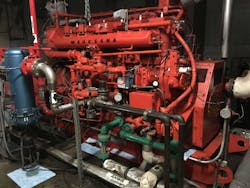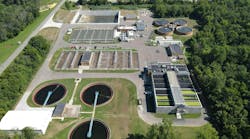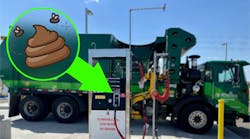Two trains of secondary treatment
All water starts its entry into the plant at the influent pumping stations, after which a diversion structure directs the flow of water to a treatment marsh of 340 acres that serve as oxidation ponds for secondary treatment.
“Typically, we move the flow through the treatment plant, which is ultimately serviced by an activated sludge system,” Keller said.
At the front of the process is the headworks system along with two screens. After initial headworks and screening, the water flows through aerated grit chambers. The grit slurry, he said, is washed with a grit washer and that washed grit then falls into a dumpster along with the materials from the headworks and screens.
“After the grit process, we add a little bit of ferric chloride,” Keller said. “I just think this is the wonder chemical of water treatment as it reduces odors, of course, [and] it helps with coagulation and solids capture, and it also knocks down a little bit of the phosphorous that’s coming into the facility.”
Following that, water enters two primary circular clarifiers, which remove 70% of the total suspended solids (TSS) and around 40% of the biochemical oxygen demand (BOD). Keller said some polymer is added to the clarifier influent, as the facility has been practicing chemically enhanced primary treatment to capture more solids.
“Those solids, of course, contain some of the BOD, so that’s less BOD going through our activated sludge process and more very energetic solids going to our anaerobic digester,” Keller said.
A weir in the primary diversion structure allows the flow over the top of the activated sludge process into the oxidation ponds because the clarifiers can handle more flow than that activated sludge system can. As such, the facility has two separate secondary treatment trains, but the ponds take several days to treat the same amount of water that the activated sludge system can treat in a matter of hours.
Activated sludge and oxidation ponds
The activated sludge process at NapaSan includes two aeration basins with a 4 MGD capacity each. They are configured with six compartments and, in 2019, the facility replaced its air diffuser system with Sanitaire diffusers, which are supplied air by two APG Neuros blowers.
“I think we were the first installation of the APG Neuros turbo blowers in North America,” he said, “and then we also installed the ammonium based aeration control in order to make sure the facility was always in full nitrification.”
He said when nitrification was incomplete, the disinfection process did not work as effectively.
As for the oxidation ponds, nine blowers feed air into the ponds to ensure dissolved oxygen does not drop too low, which Keller said happens most often with extended cloud coverage in the winter, referred to as the marine layer. The use of these ponds fulfills a mission of the board of directors that permeates other processes as well.
“The facility is really focused on using natural ways to treat water that are less energy [demanding],” Keller said, “so, in this case, we’re able to use solar energy to treat those heavy recycled streams and also to collect all the water that should fall on site.”
Another example of this includes NapaSan holding out a lease option with a solar company to install a floating solar array on the oxidation ponds. There are a handful of considerations for how it would impact treatment — particularly with potential reduced evaporation that could reduce chloride levels — but the 20 megawatt system could benefit the plant overall.
After the oxidation ponds, the water flows into a dissolved air flotation clarifier to remove the TSS from algae before it enters the tertiary treatment process, followed by chlorine contact basins for disinfection and discharge. The tertiary treatment process uses upflow filters that continuously backwash, allowing for the water to reach unrestricted use recycled water standards, also known as Title 22 water.
Progressive goals on energy and climate
The NapaSan board of directors have lofty, but achievable, goals in mind for the facility. Keller said the climate mitigation plan is driving sustainability goals.
“We’re looking to reduce our emissions, and then of course are also looking to generate electricity and become a beneficial reuse facility with all of our waste,” Keller said.
He said these goals align NapaSan’s duty as an environmental steward with the goals for affordable treatment and rates for its customers. To that end, it has explored innovative energy practices including a megawatt solar energy project that was used to charge Tesla batteries.
Its most recent innovation was a linear generator, which uses principles of electromagnetism to not only drive the device but also capture energy from it.
“What was also very attractive was the conversion efficiency of 45%,” Keller said. “Right now our co-generation conversion energy efficiency is about 20%, so 45% is very attractive.”
He said it is the first installation of the technology on biomass or a wastewater treatment plant, but the technology’s outlook is promising.
“We don’t see a reason why it shouldn’t be successful,” Keller said.
